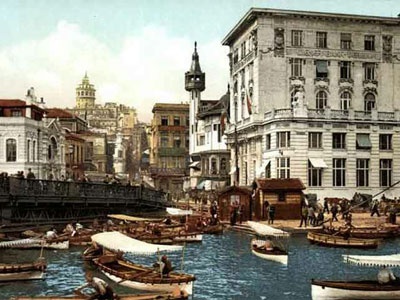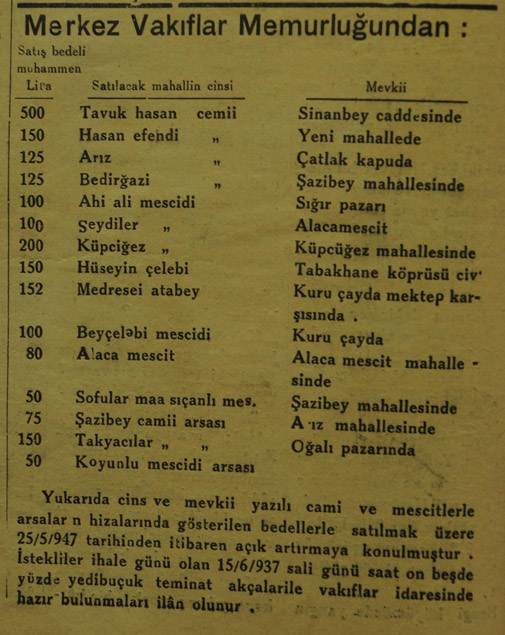
WONDERING 'COULD THEY REALLY SELL A MOSQUE?' THEY DID!
Before 1950, only three mosques were open within Istanbul’s city walls: Süleymaniye, Bayezid, and Fatih. The others were used for different purposes. The Blue (Sultanahmed) Mosque, as though no other place was available, served as a military dispatch center. Beylerbeyi Mosque’s imam, Hafiz Mustafa Efendi, recounted how some soldiers waiting for inspection, unable to leave, relieved themselves in the mosque’s corners.
Draft horses were tied to New (Yeni) Mosque, while Nusretiye Mosque was a log warehouse. Refi Cevat Ulunay even reported that the last prayer area of the mosque was demolished because one of the logs was too long. Such practices were common in many cities. For instance, in Konya, only Kapı Mosque was open, while in Ankara, only Hacıbayram Mosque remained. The few elderly men attending open mosques were among the rare attendees, as going to the mosque during a time when worshippers were viewed with suspicion required courage. Until 1950 in Bursa, 40 mosques were closed while 59 remained open. Lami Çelebi Mosque was used as a sports club. The Sultan Murad Hudavendigar (Şehadet) Mosque was where the 5th Army Corps’ band practiced music. Inside İsmail Hakkı Bursevi Mosque was a wrestling club, and its madrasa became the headquarters of the Republican People’s Party. (Bayram Sarıcan, “Bursa’da Dinî Hayat” - Religious Life in Bursa , 90-96)
When Münevver Ayaşlı visited Erzurum in 1946, she found that the mosque her great-grandfather Esad Muhlis Pasha had built during his governorship was being used as a military warehouse. Inside were old metal stoves, coiled barbed wire, and discarded cans, items even a scrap dealer would not purchase. She asked Corps Commander İzzet Aksalur, “Please, Pasha, would you reopen this mosque for the congregation? There’s nothing inside it anyway.” She continued, “Though the Pasha held me in high regard, he refused to open the mosque, saying it could not be done. We lived in dark times.” (“Geniş Ufuklara ve Yabancı İklimlere Doğru” - Towards Broad Horizons and Foreign Climates, 249-250)
.jpg)
A Mosque in a Military School?
Starting in 1927, mosques began to be categorized. A regulation was issued in 1928 stating that if more than one mosque existed within 500 meters or if no congregation was found, the mosque would be excluded from official records. This fate befell not only mosques but also churches and synagogues. For instance, the Armenian Church in Adana became Turan Cinema, with a restroom installed at the former mihrab.
Some of the hundreds of categorized-out mosques were closed, others repurposed for secular activities, and some were demolished, with their materials sold to People’s Houses (Halkevleri). Officials inspected mosques during the late afternoon prayer when few congregants were present, sealing the mosques on the grounds that they were unused. When the congregation arrived for the evening prayer, they would find their mosque locked.
Even Hagia Sophia could not escape this fate, converted into a museum by cabinet decision in 1935. The Waqf (Foundation) Law, which stated that “mosques of architectural value cannot be sold,” was disregarded. Reports required from the Ministry of Education (acting in place of the Ministry of Culture at the time) were prepared as desired to facilitate this process. Mehmet Çağlayan, a former mufti from Muş, recounted with tears how the minaret of the historic Murad Pasha Mosque was dynamited.
In 1935, Heybeliada Mosque was demolished on the grounds that “there could not be a mosque in a military school.” Over 1,000 mosques in Istanbul alone were demolished. By 1937, approximately 60% of mosques in Türkiye had been excluded from official records. In Bursa, 40 of the 64 mosques were left, and in Antep, 22 of the 39 mosques remained. This information is based on official archive records.
.jpg)
Mosques for Every Budget!
Beginning in 1927, hundreds of decommissioned mosques were auctioned to municipalities or private individuals. The formal structure came later. The Waqf Law enacted in 1935 regulated these sales.
The first mosque sold was Hacı İzzet Pasha Mosque in Sivas for 623 lira 90 kurush, and Hadice Sultan Mosque in Fatih for 4,996 lira 45 kurush. The lowest-priced mosque was Melikshah Masjid in the Servihisar district of Eskişehir, sold for 2.5 lira in 1940, while the highest was Hacet Masjid in Kayseri, sold for 57,000 lira in 1968.
Sales continued until 1972. Of the 3,900 mosques sold, 84% were sold between 1927 and 1949. Some philanthropists bought these mosques solely to preserve them, creating the opportunity to reconvert them into mosques when times improved.
After 1950, the mosques demolished were mostly sacrificed for road and bridge construction. Vatan Avenue and the Bosphorus Bridge claimed many historic mosques, and some say that Adnan Menderes (one of the founders of the Democrat Party in 1946 and the Prime Minister of Türkiye between 1950 and 1960) mourned this loss.
.jpg)
Some Were Made Warehouses, Others Nightclubs!
In Eminönü, the Hidayet Mosque, built by Sultan Mahmud II, was used as a leather warehouse; the Küçüksu Mosque became a Republican People’s Party (CHP) branch; Yıldırım Mosque in Balıkesir was turned into a People’s House (Halkevi); Sadık Mosque in Izmit became the meteorological office; and despite being near Şehzadebaşı Mosque, Burmalı Mosque, thanks to its unique twisted minaret, was spared demolition but was used as a carpenter's workshop.
Most mosques that were not converted into museums were occupied by the CHP, the military, and the Office of Soil Products. Some mosques, purchased from municipalities by private individuals, were turned into shops, houses, and even open-air cinemas. Those lamenting a mosque in Thessaloniki being converted into a cinema were somehow unaware of these conversions.
One of the most interesting stories of the mosques that fell victim to the One-Party era’s wrath is that of Ayazpaşa Mosque in Taksim, also known as Kadı Mosque. Şefik Oktay, grandson of Grand Vizier Tevfik Pasha and owner of the Park Hotel, recalls: “Mustafa Kemal would often come to the Park Hotel with his friends, enjoying his rakı (a Turkish alcoholic drink) and watching the dancers. When the call to prayer (adhan) would be heard from the nearby historic Ayazpaşa Mosque, the orchestra would stop and resume once it was over.
In [1933], while Mustafa Kemal was at the hotel and dancing was in progress, the Carmen Pady Orchestra suddenly stopped. Mustafa Kemal asked why the music had stopped so abruptly, and the reason was explained. Following this, the minaret of the mosque was demolished, and the mosque was closed for worship.” (“Büyükbabam Tevfik Paşa” - My Grandfather Tevfik Pasha, p. 102)
During the Democratic Party era, this mosque was reopened for worship, and its minaret was rebuilt. However, Heybeliada Naval Mosque, demolished in 1936 during Mustafa Kemal’s visit because having a mosque next to a military school was deemed inappropriate, still remains an empty plot.
Many of the closed mosques were reopened for worship during the Democratic Party era. Not long ago, for instance, when I was working on my doctorate, the Merzifonlu Kara Mustafa Pasha Mosque behind Sirkeci Station was used as the Anadolu Saz Nightclub. Cezeri Kasım Pasha Mosque in Cağaloğlu served as the tax office warehouse. In the late 1980s, it was reclaimed through court proceedings and restored.
The Kaptan-ı Derya Mosque beside the university in Bayezid served as a library warehouse. It was flooded, and the books were removed, after which philanthropists helped restore the mosque. During those times, President Kenan Evren complained about there being more mosques than schools, and “diligent” newspapers drew attention to the “mosque frenzy.”
(1).jpg)
Is There a Remedy to Strengthen Memory?
In the one-party era, not only mosques but also madrasas, primary schools, cemeteries, and even tombs became subject to sale. Religious officials were dismissed, and the remaining ones had their salaries reduced. These topics will, God willing, be covered in another article. Now, some may have weak memories, but many who witnessed those times are still alive and remember what they saw clearly. As the poet said, “Do you think everyone is blind, or the world is full of fools?”
If, like its predecessor the Committee of Union and Progress in 1918, the Republican People’s Party had shown the maturity to dissolve itself in 1950, it would have been spared accusations of opposing democracy, being merchants of coups, violating human rights, fascism, and hostility towards religion. Moreover, a true social democratic organization could have been established, paving the way for democracy in the country.

.jpg)
Önceki Yazılar
-
THE FIRST UNIVERSITY IN THE WORLD WAS FOUNDED BY MUSLIMS3.12.2025
-
WHO BETRAYED PROPHET ISA (JESUS)?26.11.2025
-
IT HAS BEEN MORE THAN 100 YEARS SINCE ITS ABOLITION, BUT... IS THE CALIPHATE BEING REESTABLISHED?19.11.2025
-
GREETINGS TO YOU, O OTTOMAN SANJAK!…12.11.2025
-
ROTHSCHILDS BROUGHT THE END OF THE OTTOMAN EMPIRE!5.11.2025
-
SHEIKH BEDREDDIN, SON OF THE QADI OF SIMAVNA29.10.2025
-
THE ROOTS OF THE ENGLISH POLITICIAN IN TURKEY – THE TRAGIC END OF ALI KEMAL BEY22.10.2025
-
WHERE IS THE RED APPLE?15.10.2025
-
THE ABBASIDS IN ANATOLIA1.10.2025
-
IMAMS AND MUFTIS AS OFFICERS IN THE OTTOMAN ARMY24.09.2025